
Initially, the default collation settings are shown, but these may not match the collation selected during setup. In the Collation Settings dialog box, verify or change settings used for the master database and all other databases. In the Browse for Folder dialog box, select the \Data folder on the SQL Server 2000 compact disc or in the shared network directory from which SQL Server 2000 was installed, and then click OK. In the Rebuild Master dialog box, click Browse. Program Files\Microsoft SQL Server\80\Tools\Binn. At a command prompt, enter the following command to switch the directory:. Stop the SQL Server service using the SQL Server Enterprise Manager. 
In the right pane, locate the Yosemite Server Backup service, r ight-click the service, and then click Stop.
In the left pane, click Services and Applications Services. Right-click My Computer, and then click Manage. The Yosemite Server Backup service stops on the local machine. Type the following command at the command prompt: ytwinsvc -x. At a command prompt, change to the following directory: C:\Program Files\Barracuda\Yosemite Server Backup. Stop Yosemite Server Backup and SQL Server ServicesĮxit Yosemite Server Backup, and s top the Yosemite Server Backup service by using one of the following methods. Because of this, always dump (back up) the master database after creating, expanding, or shrinking user databases.Ĭomplete the following steps to recover a damaged master database: Step 1. If a user database is created, expanded, or shrunk after the most recent dump (backup) of the master database and if it becomes necessary to reload the master database, then that user database and all data in it will be lost and must be restored from backup. 
The most common statements and system procedures that modify the master are: This is best accomplished by prohibiting the creation of user-defined objects in the master database and by being aware of the statements and system procedures, and the equivalent actions in SQL Enterprise Manager, that modify it. It is strongly recommended that the master database be backed up each time it is changed. All changes made to the master database after the last dump are lost when the dump is reloaded and therefore must be reapplied. If the master database becomes unusable, it must be restored from a previous dump. The procedure used to recover a damaged master database is different from the procedure used to recover user databases.


An example of an error might be damage caused by media failure in the area in which master database is stored. A damaged master database is evident by the failure of the SQL Server to start, by segmentation faults or input/output errors or by a report from DBCC.








 0 kommentar(er)
0 kommentar(er)
